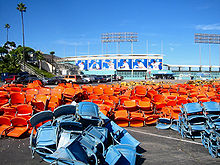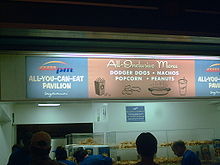- Dodger Stadium
-
Dodger Stadium Chavez Ravine 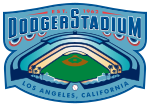
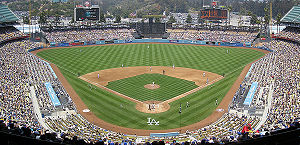
Location 1000 Elysian Park Avenue
Dodgertown, California 90090-1112
(formerly in the 90012 zip code)Coordinates 34°4′25″N 118°14′24″W / 34.07361°N 118.24°WCoordinates: 34°4′25″N 118°14′24″W / 34.07361°N 118.24°W Broke ground September 17, 1959 Built 1959-1962 Opened April 10, 1962 Owner Los Angeles Dodgers Surface Santa Ana Bermuda Grass Construction cost $23 million
($167 million in 2011 dollars[1])Architect Captain Emil Praeger Project Manager Vinell Construction Company[2] Capacity 56,000 with standing room at least
57,099Record attendance 57,099 (April 13, 2009) (Giants) Field dimensions Left Field - 330 feet (101 m)
Medium Left-Center - 360 feet (110 m)
True Left-Center - 375 feet (114 m)
Center Field - 400 feet (122 m)*
True Right-Center - 375 feet (114 m)
Medium Right-Center - 360 feet (110 m)
Right Field - 330 feet (101 m)
Backstop - 55 feet (17 m)
*Actual distance to center field is 400 ft (122 m); the 395-foot (120 m) markings are to the left and right of dead center.[3]Tenants Los Angeles Dodgers (MLB) (1962–present)
Los Angeles Angels (MLB) (1962–1965)Dodger Stadium, also sometimes called Chavez Ravine, is a stadium in Los Angeles. Located adjacent to Downtown Los Angeles, Dodger Stadium has been the home ballpark of Major League Baseball's Los Angeles Dodgers team since 1962. Dodger Stadium was constructed from 1959 to 1962 at a cost of $23 million, financed by private sources.
Dodger Stadium is currently the third oldest ballpark in Major League Baseball (behind Fenway Park in Boston and Wrigley Field in Chicago,) and is the largest ballpark by seating capacity.
The stadium hosted the 1980 MLB All-Star Game, as well as games of the 1963, 1965, 1966, 1974, 1977, 1978, 1981, and 1988 World Series.
It also hosted the semifinals and finals of the 2009 World Baseball Classic as well as exhibition baseball during the 1984 Summer Olympics. The 2012 season marks the fiftieth anniversary of the stadium.
Contents
History
Construction
In the mid-1950s, Brooklyn Dodger team president Walter O'Malley had tried to build a domed stadium in the New York City borough of Brooklyn, but was unable to reach an agreement with city officials land acquisition, and eventually reached a deal with the city of Los Angeles in California. The land for Dodger Stadium was purchased from local owners and inhabitants in the early 1950s by the city of Los Angeles using eminent domain with funds from the Federal Housing Act of 1949. The city had planned to develop the Elysian Park Heights public housing project, which included two dozen 13-story buildings and more than 160 two-story townhouses, in addition to newly rebuilt playgrounds and schools.
Before construction could begin on the housing project, the local political climate changed greatly when Norris Poulson was elected mayor of Los Angeles in 1953. Proposed public housing projects like Elysian Park Heights lost most of their support as they became associated with socialist ideals. Following protracted negotiations, the city purchased the Chavez Ravine property back from the Federal Housing Authority at a drastically reduced price, with the stipulation that the land be used for a public purpose. It was not until June 3, 1958, when Los Angeles voters approved a "Taxpayers Committee for Yes on Baseball" referendum, that the Dodgers were able to acquire 352 acres (1.42 km2) of Chavez Ravine from the city. While Dodger Stadium was under construction, the Dodgers played in the league's largest capacity venue from 1958 through 1961 at their temporary home, the Los Angeles Memorial Coliseum, which could seat in excess of 90,000 people.
Los Angeles-based Mike Davis, in his seminal work on the city, City of Quartz, describes the process of gradually convincing Chavez Ravine homeowners to sell. With nearly all of the original Spanish-speaking homeowners initially unwilling to sell, developers resorted to offering immediate cash payments, distributed through their Spanish-speaking agents. Once the first sales had been completed, remaining homeowners were offered increasingly lesser amounts of money, to create a community panic of not receiving fair compensation, or of being left as one of the few holdouts. Many residents continued to hold out despite the pressure being placed upon them by developers, resulting in the Battle of Chavez Ravine, an unsuccessful ten-year struggle by residents of Chavez Ravine, to maintain control of their property. The controversy surrounding the construction of the Dodger Stadium provided the inspiration for singer Ry Cooder's 2005 concept album, Chávez Ravine.
Dodger Stadium was the first Major League Baseball stadium since the initial construction of the original Yankee Stadium to be built using 100% private financing, and the last until AT&T Park opened in 2000. Ground was broken for Dodger Stadium on September 17, 1959. The top of a local hill was removed and the soil was used to fill in the actual Chavez Ravine, to provide a level surface for a parking lot and the stadium. A total of eight million cubic yards of earth were moved in the process of building the stadium. 21,000 precast concrete units, some weighing as much as thirty-two tons, were fabricated onsite and lowered into place with a specially-built crane to form the stadium's structural framework. The stadium was originally designed to be expandable to 85,000 seats, simply by expanding the upper decks over the outfield pavilions. However, the Dodgers have never pursued such a project.
Dodger Stadium was also the home of the Los Angeles Angels (now Los Angeles Angels of Anaheim) from 1962 through 1965. To avoid constantly referring to their landlords, the Angels called the park Chavez Ravine Stadium (or just "Chavez Ravine"), after the former geographic feature in which the stadium had been constructed.
As of 2011, Dodger Stadium is one of twelve major league parks currently without a corporate-sponsored name; the others are Turner Field, Yankee Stadium, Fenway Park, Busch Stadium, Wrigley Field, Rangers Ballpark in Arlington, Oriole Park at Camden Yards, Kauffman Stadium, Angel Stadium of Anaheim, and Nationals Park. (Busch, Kauffman, Turner and Wrigley were named for individuals rather than their corporations. Angel and Rangers once had corporate sponsorships.)
Frank McCourt era
At the conclusion of the 2005 season, the Los Angeles Dodgers made major renovations during the subsequent off-season.
The largest of these improvements was the replacement of nearly all the seats in the stadium. The seats that were removed had been in use since the mid-1970s and helped give the stadium its unique "space age" feel with a color palette of bright yellow, orange, blue, and red. The new seats are in the original (more muted) 1962 color scheme consisting of yellow, light orange, turquoise, and sky blue. 2,000 pairs of seats were made available for purchase at $250, with the proceeds going to charity.
The baseline seating sections have been converted into retro-style "box" seating, adding leg room and a table. Other repairs were made to the concrete structure of the stadium. These improvements mark the second phase of a multi-year improvement plan for Dodger Stadium.
Between 2003 and 2005, Dodger Stadium upgraded with light emitting diode (LED) video displays from Daktronics out of Brookings, South Dakota. The large main video display measures 27 feet high by 47 feet wide.[4]
In 2008, the Dodgers announced a $500 million project to build a Dodger museum, shops, and restaurants around Dodger Stadium.
- Dodger Way - A tree-lined entrance will lead to a landscaped grand plaza where fans can gather beyond center field. The plaza will connect to a promenade that features restaurants, shops and the Dodger Experience museum showcasing the history of the Dodgers in an interactive setting.
- Green Necklace - The vibrant street setting of Dodger Way links to a beautiful perimeter around Dodger Stadium, enabling fans to walk around the park, outdoors yet inside the stadium gates. This Green Necklace will transform acres of parking lots into a landscaped outdoor walkway connecting the plaza and promenade to the rest of the ballpark.
- Top of the Park - The Green Necklace connects to a large scale outdoor plaza featuring breathtaking 360 degree views spanning the downtown skyline and Santa Monica Bay, the Santa Monica and San Gabriel Mountains, and the Dodger Stadium diamond.[5]
In the 2008-2009 offseason, the upper levels of the stadium were supposed to be renovated to match the repairs and improvements made to the field level. The improvements were to include the removal of the trough urinals in the men's restrooms, new concession stands and earthquake retrofitting to the concrete structure. It was also to include the replacement of the outfield scoreboards and monitors with new HD monitors. Due to the 2009 World Baseball Classic hosted at Dodger Stadium, these renovations were put on hold. As of the 2010 season, however, the scheduled renovations are still on hold. The divorce of Frank and Jamie McCourt, as well as a weak economy, are the reasons for the postponement.[6]
To pay for an outstanding loan with the Dodgers former owner News Corporation, current owner Frank McCourt used Dodger Stadium as collateral to obtain a $250 million loan.[7] Through a series of land deals, various McCourt companies control the stadium and the Dodgers pay rent to these entities - LA Real Estate LLC for the stadium itself[8] and the 250 acres surrounding the stadium controlled by Blue Landco, LLC.[9]
In 2008, the Los Angeles City Council voted unanimously to give the Dodger Stadium area bounded by Academy Rd, Lookout Dr. and Stadium Way its own zip code, 90090 (as of July 2009). This also gives the area a new name, Dodgertown. The signs from the former Dodgertown spring training facility in Vero Beach, Florida will likely be integrated into the $500 million project.[10]
Features
Design
Dodger Stadium was one of the last baseball-only facilities built before the dawn of the multi-purpose stadium. It was built near the convergence of several freeways near downtown Los Angeles, with an expansive parking lot surrounding the stadium. With the construction of many new MLB ballparks in recent years, it is now the third-oldest park still in use, and the oldest on the West Coast.
Dodger Stadium offered several innovative design features. One of these was a covered and screened section of dugout-level seats behind home plate. Dodger owner Walter O'Malley was inspired to incorporate this feature into the Dodger Stadium design after having seen it at Tokyo's Korakuen Stadium during the Brooklyn Dodgers' postseason goodwill tour of Japan in 1956. The original dugout seating area was replaced by more conventional box seating in a 1999 renovation, but this feature has been replicated at Progressive Field in Cleveland and Angel Stadium of Anaheim.
Two of Dodger Stadium's most distinctive features are the wavy roof atop each outfield pavilion and the top of a ten-story elevator shaft bearing the Dodger logo rising directly behind home plate at the top of the uppermost seating level.
A unique terraced-earthworks parking lot was built behind the main stands, allowing ticketholders to park at roughly the level of their seats, minimizing use of ramps once inside. The stadium was also designed to be earthquake-resistant, an important consideration in California, and it has withstood several serious earthquakes.
Dodger Stadium was originally equipped with two large Fair Play electronic scoreboard units above the left- and right-field pavilions. The right-field board displayed in-game information. The left-field board displayed scores of out-of-town games and other messages. Smaller auxiliary scoreboards were installed at field level on the box seat fences beyond the first- and third-base dugouts during the inaugural 1962 season. The left-field message board was replaced by a Mitsubishi Electric DiamondVision video board in 1980. The field-level auxiliary scoreboards were replaced by larger units installed on the facade of the Loge (second) seating level in 1998; these, in turn, were replaced by a video ribbon in 2005. Field-level out-of-town scoreboards were installed on the left- and right-field walls in 2003.
Strobe lights were added in 1999; they flash when the Dodgers take the field, after a Dodger home run and after a Dodger win.
In addition to those of Don Drysdale, Sandy Koufax, and Don Sutton, the retired numbers of Pee Wee Reese, Jackie Robinson, Duke Snider, Tommy Lasorda, Walter Alston, Roy Campanella and Jim Gilliam are mounted below the pavilion roofs behind the outfield fence.
The Dodgers devote significant resources to the park's maintenance. For example, it is repainted every year, and a full-time crew of gardeners maintain the site. No plans are in the works to replace it. Renovations were made in 1999 and again in 2004 that initially added additional field level seats, particularly behind home plate where previously the only person seen there was scout Mike Brito in his trademark Panama hat tracking pitch speed. After some criticism of the sightlines with these new seats, they were replaced with box seats.
Location
Built in the Los Angeles community of Chavez Ravine in Sulfur Canyon, the stadium overlooks downtown Los Angeles and provides views of the city to the south, the green tree-lined hills of Elysian Park to the north and east, and the San Gabriel Mountains beyond the outfield pavilions. Due to dry summers in Southern California, rainouts at Dodger Stadium are rare. Prior to 1976, the Dodgers were rained out only once, against the St.Louis Cardinals, on April 21, 1967. That rainout ended a streak of 737 consecutive games without a postponement. The second home rainout, on April 12, 1976, ended a streak of 724 straight games. No rainouts occurred between April 21, 1988 and April 11, 1999 - a major league record of 856 straight home games without a rainout.[11] April 21, 1988, was the last of three consecutive rainouts from April 19. That is the only time consecutive games have been rained out at Dodger Stadium.[11]
Seating
Dodger Stadium is the only current MLB park (excluding the most recently-built parks) that has never changed its capacity. It has always held 56,000 fans, due to a conditional-use permit limiting its capacity. Every time the Dodgers add seats, they always remove an equal number of seats in the upper deck or in the pavilion to keep the capacity the same.[3] Through the sale of standing room only tickets, the Dodgers' 2009 home opener drew 57,099 fans, the largest crowd in stadium history. Following a number of incidents in the early 1970s in which fans showered Cincinnati Reds left fielder Pete Rose with beer, bottles, cups, and trash, the sale of beer was discontinued in the left field pavilion. Beer sales were reinstated in the left field pavilion in 2008. A new addition to Dodger Stadium in 2009 is the Bleacher Beach. Bleacher Beach is in the upper deck in left field and the fans sitting there have access to free food.
With the retirement of the original Yankee Stadium (1923) and Shea Stadium in 2008, the park claimed the title of being the largest capacity stadium in the Majors.
As of 2010, there are a total of 2,098 club seats and 68 luxury suites. Both of these amounts will increase once the renovations are complete.
Field dimensions and playing surface
For various reasons, Dodger Stadium has long enjoyed a reputation as a pitchers' park. At first, the relatively deep outfield dimensions were a factor, with the power alleys being about 380 feet. Home plate was moved 10 feet toward center field in 1969, but that move also expanded foul ground by 10 feet, a tradeoff which helped to offset the increased likelihood of home runs caused by the decreased field dimensions. Also, during evening games, as the sun sets, the surrounding air cools quickly due to the ocean climate, becoming more dense. As a result, deep fly balls that might otherwise be home runs during the day instead often remain in play becoming outs. The park has been home to 10 no-hitters, while players have hit for the cycle just twice in Dodger Stadium.
Recently, Dodger Stadium has been more neutral with respect to home runs.[12] The stadium does depress doubles and triples quite a bit, due to its uniform outfield walls and relatively small "corners" near the foul poles. However, the extremely short outfield walls near the foul poles also make some balls that would bounce off the wall in other parks go for home runs. With some expansion of the box seat area and the removal of significant foul territory, the ballpark has become neutral for both pitchers and hitters alike. Baseball-Reference's Park Factor measurement of 102 for the 2006 and 2007 seasons is evidence of this. In addition, foul territory, once very spacious, has been significantly reduced over the years.
Although the distance to center field has been marked at 395 feet since 1973, it is still actually 400 feet (120 m) to center, as has been the case since 1969. The two 395-foot signs erected in 1973 are to the left and right of dead center.[3]
With the opening of Citi Field and the demolition of Shea Stadium in 2009, Dodger Stadium became the only stadium with symmetrical outfield dimensions remaining in the National League and only one of four total in Major League Baseball. The other three symmetrical fields are Kansas City's Kauffman Stadium, Toronto's Rogers Centre, and Oakland-Alameda County Coliseum.
Pitchers such as Sandy Koufax, Don Drysdale, Don Sutton, Fernando Valenzuela, and Orel Hershiser became superstars after arriving in Los Angeles. The pitcher's edge is also evident in the fact that 10 no-hitters have been thrown in the stadium, including two perfect games (by the Dodgers' Sandy Koufax in 1965, and by Dennis Martínez of the former Montreal Expos in 1991). Bo Belinsky threw the first ever no-hitter in Dodger Stadium on May 5, 1962 while pitching for the Los Angeles Angels (that club referred to the park as "Chavez Ravine".)
The park's significant advantage was eroded somewhat in 1969, in general because MLB rules were changed after the "Year of the Pitcher" to lower the maximum height of the pitcher's mound, and more specifically because the Dodgers moved the diamond about 10 feet (3 m) towards center field. This also gave the fielders more room to catch foul balls, so there was some tradeoff. Following the 2004 season, the stadium underwent a renovation which significantly reduced the amount of foul territory. Seats were added which were closer to home plate than the pitcher's mound, the dugouts were moved 20 feet closer to the field, and previously open space down the foul lines was filled with new seats.
Historic events
1963 World Series
The Dodgers won the 1963 World Series over the New York Yankees, sweeping the Yanks by winning game 4 by a score of 2-1. Through 2010, this remains the only time the Dodgers ever clinched a World Series at home.
1988 National League Championship Series
Until 1988, Dodger Stadium had never hosted a seventh game of a postseason series. The Dodgers won Game 7 of the 1988 National League Championship Series over the New York Mets, 6-0.
No hitters in Dodger Stadium
(*-Perfect game)
Date Pitcher Team Opponent Box score May 5, 1962 Bo Belinsky Angels Orioles [1] June 30, 1962 Sandy Koufax Dodgers Mets [2] May 11, 1963 Sandy Koufax Dodgers Giants [3] Sept. 9, 1965* Sandy Koufax Dodgers Cubs [4] July 20, 1970 Bill Singer Dodgers Phillies [5] June 29, 1990 Fernando Valenzuela Dodgers Cardinals [6] July 28, 1991* Dennis Martinez Expos Dodgers [7] Aug. 17, 1992 Kevin Gross Dodgers Giants [8] April 8, 1994 Kent Mercker Braves Dodgers [9] July 14, 1995 Ramon Martinez Dodgers Marlins [10] Other events
- Prior to the inaugural game in 1962, the umpires discovered that the foul poles were located entirely in foul territory. The Dodgers received special dispensation from the National League to keep the poles unmoved for the 1962 season, but after the season they had to move home plate so the poles would be partially in fair territory, as required by the rules.[3]
- Four home runs have been hit completely out of Dodger Stadium. Outfielder Willie Stargell of the Pittsburgh Pirates hit two of those home runs. Stargell hit a 507-foot home run off the Dodgers' Alan Foster on August 6, 1969 that completely cleared the right field pavilion and struck a bus parked outside the stadium. Stargell then hit a 470-foot home run off Andy Messersmith on May 8, 1973 that landed on the right field pavilion roof and bounced into the parking lot. Dodger catcher Mike Piazza hit a 470-foot home run off Frank Castillo of the Colorado Rockies on September 21, 1997 that landed on the left field pavilion roof and skipped under the left field video board and into the parking lot. Finally, on May 22, 1999, St. Louis Cardinal first baseman Mark McGwire cleared the left field pavilion with a 483-foot home run off the Dodgers' Jamie Arnold.
- The Beatles played their second to last concert here in 1966.
- Dodger Stadium was the site of a brief moment in the 1971 movie, The Omega Man, in which Charlton Heston was rescued by Rosalind Cash.
- Elton John played two sold-out concerts here in 1975.
- The Fleetwood Mac song "Tusk" was recorded and filmed at the empty stadium in 1979.
- Dodger Stadium has also staged other sporting events such as boxing, a basketball game featuring the Harlem Globetrotters and a ski-jumping exhibition, as well as the baseball competition of the 1984 Summer Olympic Games.
- The Jacksons played six sold-out concerts during their Victory Tour in November and December 1984.
- The closing scene from the 1985 film Better Off Dead shows an aerial of John Cusack and his French Foreign exchange student girlfriend Diane Franklin sitting on his black Camaro at home plate.
- Pope John Paul II celebrated Mass at Dodger Stadium on September 16, 1987.
- The baseball scenes from the first Naked Gun film were filmed at Dodger Stadium, although the team represented in the film was the California Angels.
- One scene in the 1982 film I Ought to Be in Pictures was shot at Dodger Stadium.
- Depeche Mode played two sold out concerts here in 1990.
- The stadium hosted the opening ceremony of the 1991 U.S. Olympic Festival.
- Baseball games from Thursday April 30, 1992 to Sunday May 3, 1992 were postponed due to the 1992 Los Angeles riots. Three consecutive days of double headers were held later in the season.
- Dodger Stadium was the site of media day for Super Bowl XXVII played between the Dallas Cowboys and Buffalo Bills at the Rose Bowl in nearby Pasadena.
- Dodger Stadium was also the site of "Encore - the Three Tenors", a 1994 concert reuniting internationally renowned tenors Plácido Domingo, José Carreras and Luciano Pavarotti, conducted by Zubin Mehta.
- On October 31, 1998, American rock group Kiss began their Psycho Circus Tour at Dodger Stadium. This was the first tour with 3D visual effects.
- This was the starting point of a popular reality show, The Amazing Race in its fourth season
- A scene in which Paul Walker's character practices his street racing in the movie The Fast and the Furious was shot at Dodger Stadium.
- In the opening scene of the 2003 movie The Core, the Space Shuttle makes a crash landing in Los Angeles after flying over Dodger Stadium during a game. Interestingly, the shuttle is shown flying from beyond the outfield toward home plate, which would take it from the inland toward downtown. In actuality, the shuttle's approach as depicted in the film would have taken it west to east toward downtown, not over Dodger Stadium.
- On July 14, 2005, Dodger Stadium was where the Dodgers' rival San Francisco Giants became the first professional sports team to win 10,000 games, with a 4-3 win over the Dodgers.[13]
- Dodger Stadium was used as the model for Metropolis' baseball stadium in the 2006 film Superman Returns. The end of the airplane rescue scene was filmed at Dodger Stadium, and a CGI backdrop for the city was added behind the outfield.
- In a scene from the 2007 film Transformers, an empty Dodger Stadium is depicted being hit by the Autobot Jazz's protoform, which crashes through the upper deck and lands in the outfield. Though empty, the stadium's lights are on.
- A scene from the 2007 movie Fantastic Four: Rise of the Silver Surfer was also shot at Dodger Stadium.
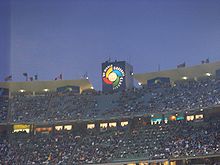 Dodger Stadium hosts the 2009 World Baseball Classic. The top of a ten-story elevator shaft bears the World Baseball Classic logo.
Dodger Stadium hosts the 2009 World Baseball Classic. The top of a ten-story elevator shaft bears the World Baseball Classic logo.
- A Baby Ruth TV commercial seen in the summer of 2007 and in the post-season tournament, in which 50,000 fans are humming "Take Me Out to the Ball Game" due to their mouths being full of the candy bar, was shot in Dodger Stadium.
- Many of the world's top rock bands have performed at Dodger Stadium, including acts such as Madonna, The Cure, KISS, The Rolling Stones, The Beatles, Bee Gees, Elton John, Simon and Garfunkel, Michael Jackson (7 nights), David Bowie, Genesis, Eric Clapton, Depeche Mode (2 Nights), U2 (2 Nights), Dave Matthews Band and Bruce Springsteen & The E Street Band. The Police played at Dodger Stadium on their reunion tour.
- In early November 2008, Madonna brought her Sticky & Sweet Tour to Dodger Stadium, which included surprise guest appearances by Britney Spears and Justin Timberlake.
- The stadium parking lot was used for the ice planet of Delta Vega and the Romulan drilling rig on Vulcan in the Star Trek movie.
- The stadium hosted the final rounds of the 2009 World Baseball Classic.
Notes
- ^ Consumer Price Index (estimate) 1800–2008. Federal Reserve Bank of Minneapolis. Retrieved December 7, 2010.
- ^ http://www.walteromalley.com/stad_facts_index.php
- ^ a b c d Lowry, Phillip (2005). Green Cathedrals. New York City: Walker & Company. ISBN 0802715621.
- ^ "Daktronics on Display at Dodger Stadium". http://www.allbusiness.com/services/amusement-recreation-services/4563919-1.html.
- ^ Hernandez, Dylan; Shaikin, Bill (April 25, 2008). "Dodgers' McCourt unveils stadium makeover plan - Los Angeles Times". http://www.latimes.com/sports/la-sp-stadium25apr25,1,6666243.story.[dead link]
- ^ Dodger Stadium work on hold - LA Observed
- ^ The Official Site of Major League Baseball: News: Dodgers to stay in place for 25 years
- ^ http://echopark.patch.com/blog_posts/dodgers-and-la-real-estate-llp-bankruptcy-actions-patch-blog
- ^ http://www.lawoona.com/dodger-chapter-11.pdf
- ^ "Dodgertown Designation Sought - Los Angeles Times". http://www.latimes.com/news/local/los_angeles_metro/la-me-dodgertown8-2008oct08,0,3709286.story.[dead link]
- ^ a b Dodger Stadium
- ^ ESPN - MLB Park Factors - Major League Baseball
- ^ Thoma, Mark (July 15, 2005). "Vizquel's blast powers Giants". MLB.com. http://mlb.mlb.com/news/article.jsp?ymd=20050715&content_id=1131564&vkey=recap&fext=.jsp&c_id=mlb. Retrieved March 2, 2011.
General references
- Clem's Baseball: Source for dimensions
- Ballpark Digest Visit to Dodger Stadium
- Dodger Stadium history and facts
- Official Website of former Dodger owner Walter O'Malley
- [11]
External links
Links to related articles Events and tenants Preceded by
Los Angeles Memorial ColiseumHome of the
Los Angeles Dodgers
1962 – presentSucceeded by
CurrentPreceded by
Wrigley FieldHome of the
Los Angeles Angels of Anaheim
1962 – 1965Succeeded by
Angel Stadium of AnaheimPreceded by
The KingdomeHost of the All-Star Game
1980Succeeded by
Cleveland StadiumPreceded by
PETCO ParkWorld Baseball Classic
Final Venue
2009Succeeded by
TBDLos Angeles Angels of Anaheim Formerly the Los Angeles Angels, the California Angels, and the Anaheim Angels · Based in Anaheim, California (Greater Los Angeles)The Franchise History · Expansion Draft · Seasons · Records · No-hitters · Awards & League Leaders · Players · Managers · Owners and executives · Opening Day starting pitchersBallparks Wrigley Field · Chávez Ravine (Dodger Stadium) · Angel Stadium of Anaheim
Spring Training: Angels Stadium · Tempe Diablo StadiumCulture Rivalries Retired Numbers Minors AAA: Salt Lake Bees AA: Arkansas Travelers A: Inland Empire 66ers of San Bernardino · Cedar Rapids Kernels Rookie: Orem Owlz · AZL Angels · Dominican LeagueKey personnel World Series
Championships (1)American League
Pennants (1)Division titles Broadcasting Seasons (51) 1960s-1970s 1980s-1990s 2000s-2010s Current ballparks in Major League Baseball American League EastCentralWestNational League EastCentralWest2009 World Baseball Classic Stadiums Tokyo Dome (Tokyo) • Foro Sol (Mexico City) • Rogers Centre (Toronto) • Hiram Bithorn Stadium (San Juan) • Petco Park (San Diego) • Dolphin Stadium (Miami Gardens, FL) • Dodger Stadium (Los Angeles)
Areas north and west of downtown Los Angeles Districts and
neighborhoodsAngelino Heights · Echo Park · Elysian Park · Elysian Heights · Elysian Valley· Franklin Hills · Historic Filipinotown · Los Feliz · Mission Junction · Pico-Union · Silver Lake · Solano Canyon · Sunset Junction · Westlake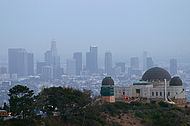
Points of
interestSee also Downtown · Eastside/Northeast · Harbor Area · Greater Hollywood · Westlake & Silver Lake/Los Feliz · San Fernando and Crescenta Valleys · South Los Angeles · Westside · WilshireCategories:- Buildings and structures completed in 1962
- 1962 establishments
- Landmarks in Los Angeles, California
- Los Angeles Dodgers stadiums
- Los Angeles Angels stadiums
- Major League Baseball venues
- Sports venues in Los Angeles, California
- Baseball venues in California
- Olympic baseball venues
Wikimedia Foundation. 2010.

